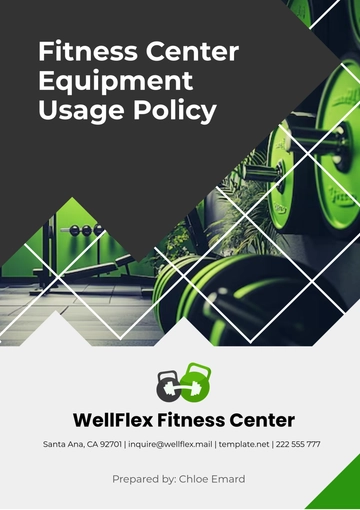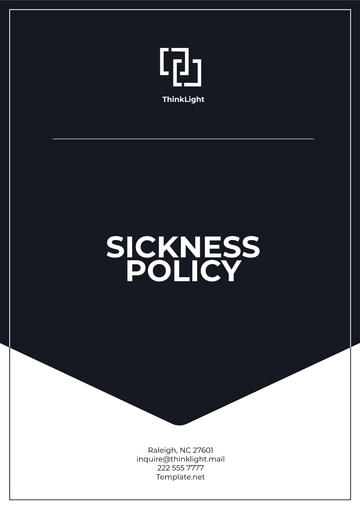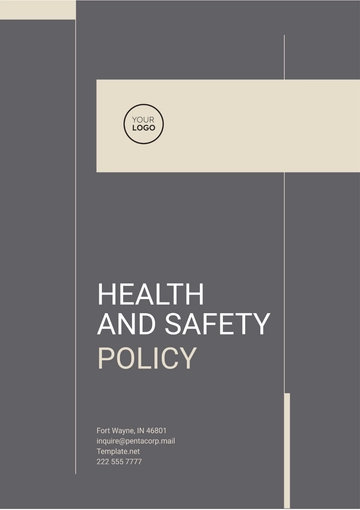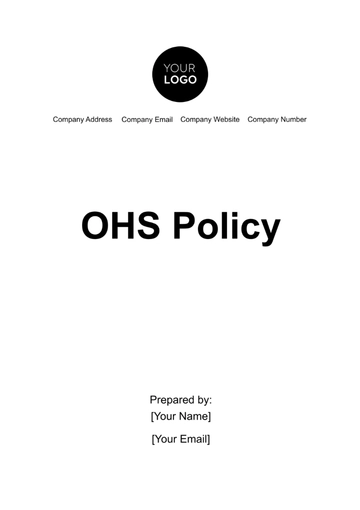Free Occupational Health %26 Safety %28OHS%29 Policy

I. Introduction
At [Your Company Name], we are deeply committed to ensuring the health, safety, and well-being of our employees. Occupational Health & Safety (OHS) is a fundamental aspect of our operational strategy, reflecting our dedication to creating a work environment that prioritizes the welfare of our team members. Our OHS policy is designed to meet and exceed the regulatory requirements set forth by the Occupational Safety and Health Administration (OSHA) and other relevant authorities. By adhering to these standards, we aim to mitigate risks, prevent accidents, and maintain a safe and productive workplace.
Our approach to health and safety is proactive, involving continuous risk assessments, comprehensive training programs, and rigorous safety protocols. We recognize that maintaining a safe workplace is a shared responsibility that involves every employee, from top management to frontline staff. [Your Company Name] is committed to fostering a culture of safety where employees feel empowered to identify hazards, report unsafe conditions, and contribute to the overall safety efforts. Through collaboration, regular safety reviews, and ongoing education, we strive to ensure that our workplace remains free from health and safety risks, thereby enhancing the overall work experience and operational efficiency.
II. Scope
The Occupational Health & Safety (OHS) Policy at [Your Company Name] applies to all employees, contractors, and visitors on our premises, including those involved in any activities related to our business operations. This policy covers all aspects of our operations, including but not limited to, administrative offices, production areas, and remote work environments. It is designed to address potential health and safety hazards across our various operational settings and ensure compliance with applicable federal, state, and local regulations.
The scope of our OHS policy encompasses the following areas:
Workplace Safety: Ensuring that all physical work environments are maintained to prevent accidents and injuries.
Emergency Preparedness: Establishing protocols for responding to emergencies such as fires, natural disasters, and medical incidents.
Health and Wellness Programs: Promoting initiatives that support the physical and mental well-being of employees.
Training and Awareness: Providing comprehensive training on safety procedures, hazard recognition, and emergency response.
Risk Assessment and Management: Regularly identifying and evaluating potential risks to mitigate safety hazards.
III. Responsibilities
In fostering a safe and healthy work environment, clearly defined responsibilities are essential. At [Your Company Name], we recognize that effective occupational health and safety (OHS) management relies on the active participation and commitment of all individuals involved. Each group within the organization has a distinct role in upholding our safety standards, ensuring compliance with regulations, and contributing to a culture of safety.
The following table outlines the specific responsibilities of management, employees, contractors, and visitors concerning our OHS policy. This structured approach helps delineate roles and expectations, facilitating clear communication and accountability across all levels of the organization. By adhering to these responsibilities, we collectively enhance our efforts to maintain a secure and productive workplace.
Role | Responsibilities |
|---|---|
Management |
|
Employees |
|
Contractors and Visitors |
|
IV. OHS Programs and Procedures
To maintain a safe and healthy workplace, [Your Company Name] is committed to implementing robust Occupational Health & Safety (OHS) programs and procedures. These initiatives are designed to proactively address potential hazards, ensure effective emergency response, and provide ongoing education to our employees. By establishing these programs, we aim to create a work environment where safety is integral to our daily operations.
The table below outlines the key OHS programs and procedures that our organization will implement. This structured framework provides clarity on how we will address hazard identification, incident reporting, emergency preparedness, and employee training. Each component is essential to building a comprehensive safety culture and ensuring that all employees are equipped to contribute to a safe work environment.
Program/Procedure | Details |
|---|---|
Hazard Identification and Risk Assessment |
|
Incident Reporting and Investigation |
|
Emergency Preparedness and Response |
|
Training and Education |
|
V. OHS Performance Monitoring
To ensure the effectiveness and continuous improvement of our Occupational Health & Safety (OHS) programs, [Your Company Name] is dedicated to rigorous performance monitoring. Regular assessment of our safety initiatives is crucial to maintaining high standards and addressing any emerging issues. By systematically reviewing performance metrics, conducting thorough audits, and actively seeking employee feedback, we can refine our OHS policies and procedures. This commitment to ongoing evaluation and enhancement helps us uphold a safe and healthy work environment for everyone in our organization.
To ensure the effectiveness of our OHS programs, we will:
Regularly monitor and review OHS performance metrics.
Conduct OHS audits and inspections.
Gather feedback from employees on OHS matters.
Continually improve OHS policies and procedures based on performance data and feedback.
VI. Communication and Consultation
Effective communication and consultation are cornerstones of a successful Occupational Health & Safety (OHS) program at [Your Company Name]. We believe that engaging with employees and OHS representatives is essential for identifying and addressing safety concerns, fostering a proactive safety culture, and ensuring continuous improvement in our safety practices. By promoting open dialogue and actively involving our team in discussions about significant safety issues, we not only enhance workplace safety but also build a collaborative environment where every voice contributes to our shared goal of a secure and healthy workplace. Establishing safety committees further supports this commitment by providing a structured approach to ongoing safety initiatives and concerns.
Our organization values the input of all employees regarding workplace safety. Therefore, we will:
Foster open communication on OHS issues.
Consult with employees and OHS representatives on significant safety matters.
Establish safety committees to address ongoing OHS concerns and initiatives.
VII. Compliance and Continuous Improvement
At [Your Company Name], our dedication to Occupational Health & Safety (OHS) extends beyond mere adherence to regulations; it is a dynamic and evolving process. Our commitment involves a proactive approach to regularly reviewing and updating our OHS policies and procedures to reflect the latest industry standards and best practices. This ongoing review ensures that our safety protocols remain effective in mitigating risks and addressing emerging challenges. By staying current with the latest regulations and advancements in safety practices, we maintain a high standard of workplace safety and compliance.
Ensuring compliance with local, state, and federal OHS regulations is a fundamental aspect of our commitment. We rigorously follow all applicable laws and standards, conducting regular audits and inspections to verify our adherence. This compliance not only helps us avoid legal repercussions but also reinforces our dedication to maintaining a safe and healthy work environment. We actively monitor changes in regulations and adapt our practices accordingly to ensure we are always in line with current requirements.
Continuous improvement is at the heart of our OHS strategy. We strive to enhance our safety performance by systematically evaluating our programs and soliciting feedback from employees. This feedback loop enables us to identify areas for improvement and implement corrective actions as needed. Performance evaluations, combined with insights from our team, drive the refinement of our safety practices and contribute to an evolving safety culture. By embracing a mindset of continuous improvement, [Your Company Name] ensures that our OHS policies and procedures not only meet but exceed expectations, fostering a safer and more resilient workplace for all.
VIII. Conclusion
The implementation of this Occupational Health & Safety (OHS) policy underscores [Your Company Name]’s unwavering commitment to fostering a safe and healthy work environment. By adhering to the principles outlined in this policy, we aim to proactively prevent work-related injuries and illnesses, ensuring that every individual associated with our operations is protected and supported. Our comprehensive approach, which includes rigorous hazard identification, effective incident reporting, emergency preparedness, and continuous training, reflects our dedication to creating a workplace where safety is paramount.
We recognize that achieving a safe work environment is an ongoing endeavor that requires the active participation of all employees, contractors, and visitors. By engaging with and implementing the strategies and procedures detailed in this policy, we not only comply with regulatory standards but also cultivate a culture of safety and well-being. Our commitment extends beyond mere compliance; we strive for excellence in all aspects of occupational health and safety. Through continuous improvement and open communication, [Your Company Name] is determined to enhance our safety practices and ensure that our workplace remains a model of health and safety standards, benefiting everyone involved in our operations.
- 100% Customizable, free editor
- Access 1 Million+ Templates, photo’s & graphics
- Download or share as a template
- Click and replace photos, graphics, text, backgrounds
- Resize, crop, AI write & more
- Access advanced editor
Ensure workplace safety with Template.net's Occupational Health & Safety (OHS) Policy Template. This fully editable and customizable template helps you establish clear safety guidelines. Tailor it to your organization's needs, editable in our Ai Editor Tool, for a professional and compliant OHS policy that protects your team.
You may also like
- HR Policy
- Restaurant Policy
- Company Policy
- Accounting Policies and Procedures
- Website Policy
- Privacy Policy
- Safety Policy
- School Policy
- IT and Software Policy
- Law Firm Policy
- Construction Policy
- Interior Design Policy
- Travel Agency Policy
- Education Academic Policy
- Security Policy
- Real Estate Policy
- Expense Policy
- Software Policy





























